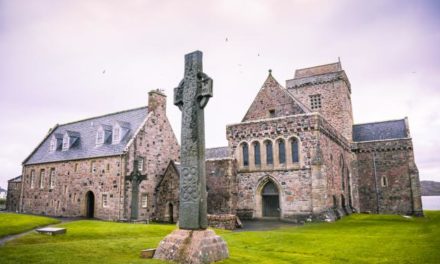This episode is titled Colonies.
The 16th C saw the growth of the Spanish and Portuguese overseas empires. The Spanish Empire included Mexico, extending well into what is now the western half of North America. In the 17th C, other Europeans began their own empire-building. The most successful of the new colonial powers was Great Britain. Among its first overseas enterprises were the thirteen colonies in North America. Though we’ve already talked about the settling of Plymouth and the Puritan settlements of Massachusetts, we’ll do a little review.
The first British colonial ventures in North America failed. In 1584, Sir Walter Raleigh was granted a charter for colonization. He named the area Virginia, after the Virgin Queen Elizabeth. But his first two ventures failed. The first group of settlers returned to England, while the second disappeared.
Then, in 1607 the first permanent colonization of Virginia began at Jamestown, named after the new British King James. There was a chaplain among them since the Virginia Company who sponsored the venture hoped to establish the Church of England in the new land and to offer its services both to the settlers and Indians. It also hoped the new colony would halt Spanish expansion, which was feared for its spread of the dreaded “popery,” as Puritans called Catholicism. But the colony’s main purpose was economic rather than religious. The Church of England never had a bishop in Virginia or in any of the other colonies. The stockholders of the Virginia Company simply hoped trade with the Indians, along with whatever crops the settlers grew, would bring a profit.
The founding of Virginia took place at the high point of Puritan influence in the Church of England. // Several of the stockholders and settlers believed the colony should be ruled by Puritan principles. Its early laws required attendance at worship twice a day, strict observance of Sunday as a day of rest and worship, and the prohibition of profanity and immodesty. But King James detested Puritans, and would not allow his colony to be ruled by them. A war with the native Americans in 1622 became the excuse to bring Virginia under his direct rule. After that, Puritan influence waned. Later Charles I, following James’s anti-Puritan policy, carved out a large part of Virginia for a new colony called Maryland and placed it under the Catholic proprietor, Lord Baltimore. Maryland was intended to be a Roman Catholic enclave in the British North American colonies. While many Catholics did move there, Protestants outnumbered them.
The Puritan Revolution in England made little impact on Virginia. The colonists were more interested in growing the new cash crop of tobacco and opening new lands for its cultivation than in the religious strife going on back in merry old England. Puritan zeal lost its vigor in the midst of economic prosperity. One of the things that led to this spiritual decline was the acceptance of slavery.
Tobacco is a labor-intensive crop. The importation of cheap labor in the form of African slaves allowed the colonists to grow the tons of tobacco now all the rage in Europe. But the Protestant work ethic that lay at the heart of so much of the Puritan mindset was gutted by slavery. Simply put, Puritan colonists lost touch with why the Puritans back in England wanted to reform the government and Church of England.
Prior to Abolition, the Church of England neglected evangelizing slaves. They did so because of an ancient principle prohibiting Christians from holding fellow believers in slavery. If a slave got saved, his owner was obliged to free her/him. Then, in 1667, a law was passed saying baptism didn’t change a slave’s legal status as the property of his owner.
While the new and emerging American aristocracy of Virginia remained Anglican, many in the lower classes turned to dissident movements. When strict measures were taken against them, hundreds migrated to Catholic Maryland, where there was greater religious freedom. The Quakers and Methodists took turns making successful forays into Virginia’s church scene.
Other colonies were founded south of Virginia. The Carolinas, granted by the crown to a group of aristocratic stockholders in 1663, developed slowly. To encourage immigration, the proprietors declared religious freedom, which attracted dissidents from Virginia and England. It didn’t take long before the people who settled in the new colonies claimed little to no religious affiliation other than a generic “Christian.”
Georgia was founded for two over-arching reasons. The first was to halt Spanish expansion. The second was to serve as an alternative for England’s overcrowded debtors’ prisons. At the beginning of the 18th C, there were many who wanted to help the sorry lot of those in England who’d fallen into poverty and couldn’t get out. One of the leaders of this campaign was a military hero named James Oglethorpe. He thought a colony ought to be founded in North America to serve as an alternative to the imprisonment of debtors. A royal charter was granted in 1732, and the first convicts arrived the next year. To these, others were soon added, along with a large group of religious refugees. Although Anglicanism was the official religion of Georgia, it made little impact on the colony. The failure of the Wesleys as Anglican pastors in the colony was typical of others. The Moravians had a measure of success, although their numbers were never large. The most significant religious movement in the early years of Georgia was the response to Whitefield’s preaching. By the time of his death in 1770, he’d left his stamp on much of Georgia’s religious life. Later, Methodists, Baptists, and others harvested what he’d sown.
As we’ve seen in previous episodes, it was farther north, at Plymouth and around Boston that Puritanism made its greatest impact. When Roger Williams was banished, he settled Providence, around which the colony of Rhode Island eventually coalesced.
The Hutchinsons and their supporters started Connecticut.
The Puritans, who baptized their children, were influenced by the Pietistic belief in the necessity of a conversion experience in order to be a genuine Christian. The question then rose; “Why do we baptize children if people don’t become Christians till they are converted?” Wouldn’t it be wiser to wait till someone was converted, then dunk ‘em – like, BTW, the Baptists do in Rhode Island? Some wanted to follow this new course. But that clashed with the Puritan goal of founding a Christian society, one in covenant with God and guided by biblical principles. A Christian commonwealth is conceivable only if, as in ancient Israel, one becomes a member by birth, so that the civil and the religious communities are the same. So children HAD to be baptized because that’s how you become part of the Church, and the Church and society were one and the same, just as in ancient Israel they entered the covenant by circumcision as infants.
To make matters even MORE complicated à If infants were baptized so as to make them “children of the covenant,” what was to be done with infants born of baptized parents who never had a conversion experience?
Many came to the conclusion there needed to be a kind of “halfway covenant,” that included those who were baptized but had no personal conversion experience. The children of such people were to be baptized, for they were still members of the covenant community. But only those who had experienced a conversion were granted full membership in the church and were vested with the power to participate in the process of making decisions.
This controversy engendered bitter arguments and monumental ill-will which turned the original optimism of the settlers into a dark foreboding. The tension over the Half-Way Covenant spilled over into new debates over how churches ought to be governed and over relations between local congregations who took different sides in the controversies that began to swirl. The majority settled on a form of church government called Congregationalism. They managed to maintain a grip on doctrinal orthodoxy by adhering to the Westminster Confession.
As mentioned, the main center of Roman Catholicism in the North American British colonies was Maryland. In 1632, Charles I granted Cecil Calvert, whose noble title was Lord Baltimore, rights of colonization over a region claimed by Virginia. Calvert was Catholic, and the grant was made by Charles in an attempt to garner Catholic support. Catholics in England wanted a colony where they could live without the restrictions they faced at home. Since it was politically unwise to establish a purely Catholic colony, it was decided Maryland would be a realm of religious freedom.
The first settlers arrived in 1634, with only a tenth being Catholic aristocrats. The other nine-tenths were their Protestant servants. Tobacco quickly became the colony’s economic mainstay, giving rise to large, prosperous plantations. Maryland was governed by Catholic landowners, but the majority of its residents were Protestants. Whenever the shifting political winds in Britain gave opportunity, Protestants sought to wrest power from the Catholic aristocracy. They succeeded when James II was overthrown. Anglicanism then became the official religion of Maryland and Catholic rights were restricted.
Because of the religious liberty practiced as policy in Pennsylvania, a good number of Catholics settled there. Catholicism then made significant gains after the Stuarts were restored to the throne in England. But after the fall of James II, the growth of Catholicism in all thirteen colonies was restricted.
The colonies of New York & New Jersey, weren’t, at first, religious refuges for any particular group. Pennsylvania was founded as a home for Quakers. But not solely so. William Penn envisioned the colony as a place of religious freedom for all. The same was true for Delaware, which Penn purchased from the Duke of York, and was part of Pennsylvania until 1701.
The religious history of New Jersey is complex. East New Jersey leaned toward the strict Puritanism of New England, while the West favored the tolerance of the Quakers. Sadly, many Quakers in New Jersey became a slaveholding aristocracy whose relations with the more traditional abolitionist Quakers of Pennsylvania became strained.
What became New York was first colonized by the Dutch, whose East India Company established headquarters in Manhattan, and whose Reformed Church came with them. In 1655, they conquered a rival colony the Swedes founded on the Delaware River, then they were in turn conquered by the British in 1664 in a minor contest. What had been New Netherland became New York. The Dutch who stayed, most of them it turned out, became British; which they happily consented to, since their homeland hadn’t given them support. The British replaced the Dutch Reformed Church with the Church of England, whose only members were the governor’s party until more British arrived and settled.
We end this episode noting religious motivations played an important role in the founding of several of the British colonies in America. Although at first, some were intolerant of religious diversity, time softened that policy, and the colonies tended to emulate the example of Rhode Island and Pennsylvania, where religious freedom existed from their inception. Such tolerance eased the natural tensions that rival colonies had as they vied for economic prosperity. The colonies also witnessed from afar the religious tensions ripping the mother country apart. That may have moved them to cool their intolerance in favor of a more liberal policy of religious freedom. But other factors were at work that combined to erode the religious fervor of the early settlers of the thirteen colonies. Slavery, the social inequality of a plantation-based economy, the exploitation of Indians and their lands, combined to work against the conscience of the English settlers. They found it difficult to follow the pattern of New Testament Christianity while engaging in practices they knew violated the Spirit of Christ. They entered a phase of national life where a desire for wealth eclipsed the conviction of the Spirit. The result was a spiritual malaise that deadened the religious fervor of the colonies.
But as we’ve seen repeatedly in our study of Church History, a period of spiritual declension either resolves in widespread apostasy or spiritual renewal. What would it be for the British colonies in North America? We find out, in our next episode.
A donation of any amount to keep CS up and running is appreciated. You can donate by going to the sanctorum.us page and following the link. Thanks.





